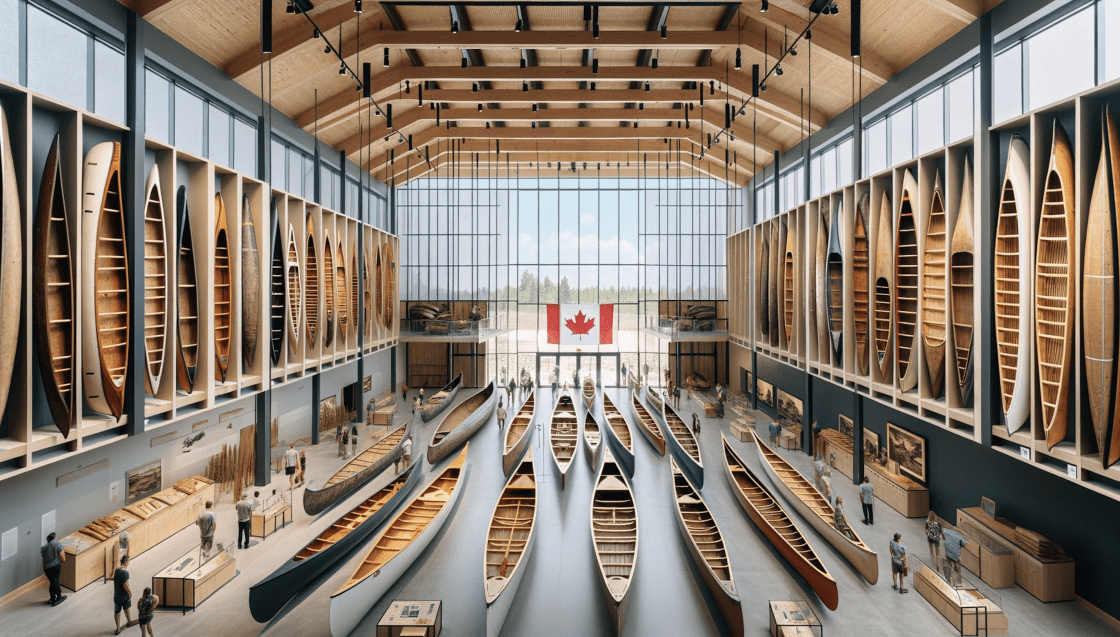Located in the picturesque landscape of Peterborough, Ontario, the newly opened Canadian Canoe Museum (CCM) promises a unique blend of history, culture, and architectural brilliance. This state-of-the-art facility, designed by Unity Design Studio and constructed by Chandos Construction, offers a captivating journey through Canada’s rich canoeing heritage. With its grand opening, the museum has become a beacon of cultural preservation and innovative design, beckoning visitors from near and far to explore its extensive collection and immersive exhibits.
A Visionary Design: The New Home of Canadian Canoes
The Canadian Canoe Museum’s new location at 2077 Ashburnham Drive, also known as the Johnson property, stands as a testament to thoughtful and innovative design. Unity Design Studio, formerly Lett Architects, collaborated with Chandos Construction and a host of other specialists to bring this vision to life. The two-storey, 65,000-square-foot building is not just a museum but a celebration of architectural ingenuity.
Overcoming Challenges: From Contamination to Construction
The journey to the museum’s new home was not without its challenges. Initially, the pandemic revealed contamination issues at the selected site, necessitating a search for a new location. After thorough analysis, the Johnson site was chosen, despite its complexities, including floodplain concerns. The site’s existing berm, a remnant of an old rail line, provided a natural balance, facilitating construction without exacerbating flood risks.
A Showcase of Canoes: Collection Storage and Exhibition
One of the most striking features of the new museum is its approach to collection storage. Unlike traditional museums where storage is hidden, the CCM proudly displays its vast collection. Visitors are greeted by an awe-inspiring sight of over 600 canoes, kayaks, and paddled watercraft. Approximately 100 canoes are showcased in the main exhibit, while the remaining 500 are stored in a dedicated hall, all meticulously arranged on adjustable pallets crafted by a local steel shop.
Innovative Spaces: Blending Functionality and Aesthetics
The museum’s design harmoniously blends functionality with aesthetics. The atrium, a grand space filled with natural light, connects various sections of the museum. Adjacent to the atrium is an artist workshop, where visitors can observe canoe and paddle construction in real-time. The second floor features a multi-purpose events room with a scenic patio overlooking Little Lake, along with administrative offices, a catering kitchen, and a comprehensive library and archives.
Sustainable and Thoughtful Materials
Sustainability and local sourcing were key considerations in the museum’s construction. The building features locally sourced cladding materials, including Corten steel, which offers the visual warmth of wood without the maintenance. The interior showcases mass timber, glulam columns, and cross-laminated timber panels, creating a cozy yet grand atmosphere.
A Campus for Learning and Community Engagement
The museum is more than just a repository of artifacts; it’s a dynamic campus designed to foster community engagement and experiential learning. Located on the water’s edge of the Trent Severn Waterway, the CCM offers interactive programming that brings its collections to life. The site includes indoor and outdoor multipurpose spaces for events, workshops, and community gatherings, ensuring accessibility and inclusivity for all visitors.
Honouring Indigenous Heritage and Fostering Connections
The Canadian Canoe Museum is deeply committed to honouring Indigenous traditions and fostering connections. Guided by the Calls to Action from the Truth and Reconciliation Commission of Canada, the museum collaborates with First Nations, Métis, and Inuit communities to ensure their voices and stories are integral to the exhibits. The museum’s name is translated into Anishnaabemowin, reflecting its location on Treaty 20 Michi Saagiig territory and the traditional lands of the Williams Treaties First Nations.
A Cultural Beacon: National and International Recognition
Recognized as one of National Geographic’s Best Cultural Spots for 2024, the Canadian Canoe Museum stands out as a must-visit destination. Its world-class collection and innovative design have garnered international acclaim, positioning it as a cultural beacon that celebrates Canada’s rich canoeing heritage and fosters a deeper understanding of our collective past.
A Rich Historical Legacy
The Canadian Canoe Museum has a storied history, dating back to its founding as the Kanawa Museum in 1957 by Kirk Wipper at Camp Kandalore, north of Minden, Ontario. The museum, initially known as the Kanawa International Collection of Canoes, Kayaks, and Rowing Craft, began with a single dugout canoe from circa 1890. Over the years, the collection grew, necessitating a new home. In 1994, Wipper transferred control of his historic collection, leading to the establishment of the Canadian Canoe Museum.
The museum opened its doors to the public at its former location, a repurposed outboard motor factory, on Canada Day in 1997. Over the decades, it expanded its collection to over 600 canoes, kayaks, and thousands of related artifacts. The museum gained royal patronage in 2006 when Prince Andrew visited to celebrate its 10th anniversary and donated three historically significant canoes.
Transporting a National Treasure
The move to the new facility began in July 2023, with the monumental task of transporting the collection to its new lakeside home near the Trent-Severn Waterway canal lock. The grand opening on May 11, 2024, was marked by the presence of dignitaries and a video message from the Prime Minister of Canada.
Interactive and Immersive Exhibits
The Canadian Canoe Museum’s exhibits delve deep into how the canoe has shaped the Canadian character and spirit. Highlights include a dramatic waterfall, a traditional Mi’kmaq wigwam, and the Preserving Skills Gallery where visitors can try their hand at building a birch bark canoe. Other engaging exhibits allow visitors to experience life as a voyageur during the fur trade era, plan a prospecting expedition, and enjoy early 20th-century cottaging lifestyles.
A notable exhibit, “Reflections: The Land, the People and the Canoe,” launched in October 2001, features Pierre Trudeau’s famous buckskin jacket and birch bark canoe, along with personal artifacts from significant paddlers like Bill Mason, Victoria Jason, and Eric Morse.
Plan Your Visit
Located at 2077 Ashburnham Drive, Peterborough, Ontario, the Canadian Canoe Museum is open daily from 10 am to 5 pm, with extended hours until 8 pm on Thursdays. The museum is affiliated with the Canadian Museums Association, the Canadian Heritage Information Network, and the Virtual Museum of Canada.
Closing Thoughts: A Journey of Discovery Awaits
The Canadian Canoe Museum in Peterborough, Ontario, is not just a museum; it’s a journey of discovery, connection, and inspiration. From its visionary design and extensive collection to its commitment to sustainability and community engagement, the museum offers an unparalleled experience. Whether you’re a history enthusiast, a canoeing aficionado, or a curious visitor, the CCM invites you to paddle through Canada’s storied past and explore the narratives that have shaped our nation.
Come, be part of this remarkable voyage, and let the Canadian Canoe Museum inspire your sense of adventure and discovery.


